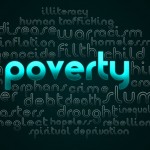In “The House on Mango Street,” by Sandra Cisneros, the thematic motif of poverty is explored throughout the story by Ezperanza’s environment and lifestyle.
At the beginning of the story, the family’s state of poverty is visualized as Ezperanza’s house was characterized. The house had “bricks [that were] crumbling in places, and the front door [was] so swollen you[‘d] have to push hard to get in (Cisneros 4).” This establishes the constant battle they have with this hardship and the depth of poverty the family is in as the house they own is falling apart. They don’t own enough money to have a house that is actually functional and stable. Also, the house’s description is explained deeper as “the paint [was] peeling, [and] wooden bars Papa had nailed on the windows so [the family] wouldn’t fall out (5).” This house represents nothing but a sign of poverty. It’s as if no one lives there, but the family is in such poverty that they can’t do anything to make the house look as if there is a living soul inside. The house symbolizes the family as the family is broken and torn apart as well. The family keeps moving from house to house in attempt to repair their poor condition, but it never gets better.
In the middle of the story, the theme of poverty is represented through Ezperanza’s living conditions. For example, Ezperanza pointed her house to Sister Supreme, “That one? [Sister Supreme] said, pointing to a row of ugly three-flats, the ones even the raggedy men are ashamed to go into (45).” The family’s state of poverty is so bad that they can’t repair their house to the point that the raggedy men would even want to live in. The men that live on streets and have terrible clothes are more proud living without a roof on their head than living at that house. In addition, the story states that “[Ezperanza] needed money (55).” This visualizes, plain and simple, that the family is poor. She needed money desperately, so she decided to lie about her age and get a job. Her family needed change and she decided that she would start it.
The thematic motif of poverty is expressed at the end of the story through a man’s dedication for his family and Ezperanza’s realization of the state of poverty her family is in. For example, “[The man] worked two jobs. He came home late and he left early. Every day (76).” Now, no one in his or her right mind would want to work. This man has to work two jobs in order to support his family. He never got a single day off. He worked continuously from bright and early to late at night to try to gain as much money as possible. Also, Alicia states, “You (Ezperanza) live right here, and points to the house I am ashamed of (91).” The fact that Ezperanza was ashamed of her own house, as a teenager, represents the sense of poverty she has within herself. The house that the raggedy men were ashamed of, the one with the paint peeling off, and the one with broken windows; this is a symbolism of the extreme depth of poverty her family is in. Everything around them is shameful and poor, her environment, Mango Street, and her identity.
Thus, throughout the entire story, the thematic motif of poverty is visualized and described by the environment and conditions of characters. They had to live through this hardship and face it head on, and whether they wanted to change their identity or not was their choice.




